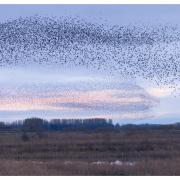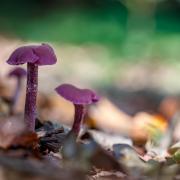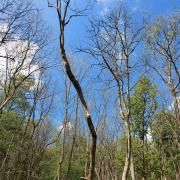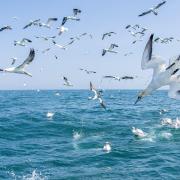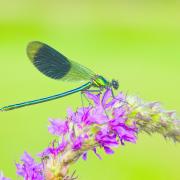As the leaves begin to turn, our hedgerows and forest floors become a gastronomic bounty. Yorkshire Wildlife Trust’s Tom Marshall takes a culinary tour and investigates the wildlife joining us at the autumn dinner table.

For the last few weeks and during those to come, trees and shrubs across Yorkshire’s fields, roadsides and gardens will be putting all their efforts into producing an array of fruits, nuts and berries ahead of the impending colder months. A vital part of Mother Nature’s seasonal story, this profusion of (mostly) edible delights can not only bolster our own menus, but those of the local wildlife too.
Generally produced by plants to encourage animals’ assistance in the distribution of the next generation, seeds or nuts are often packaged in nutritious fruit pulps which are valued by dozens of creatures large and small; both to feast on now and as a reserve against the lean months of the coming winter. In some cases, a handful these fruit and berry pulps may offer the same calorific content as a chocolate bar, and although they might be missing the classic topping of crumble and custard, we’re certainly not the only ones who enjoy a fruity feast in October.
Berry tasty

The blackberry, fruit of the bramble (rubus fruticosus), is our commonest wild fruit and for many, collecting blackberries is part of the autumn ritual in the countryside. Yet we shouldn’t take them for granted; they are a vital food source for many birds including migrants like blackcaps and rare barred warblers (seen recently at Spurn Point), as well as a range of mammals including wood mice, dormice and even foxes will who will delicately pick off the ripe fruit.
Where brambles hang over rivers and stream sides, it’s not unknown to find water voles reaching up to pick off the fruit as treat among their more typical (and somewhat less palatable) diet of grasses and nettles. For us, as well as eating the fruit straight from the bush they can of course be made into puddings, pies and jams.
The rowan (sorbus acuparia) or mountain ash, is a woodland tree, but the tree and its cultivars are often planted ornamentally in towns. Their clusters of small orangey-red berries are irresistible to winter-visiting fieldfares and redwings (members of the thrush family), along with familiar faces like blackbirds. The real showstopper however, comes in the unmistakeable and exotic-looking shape of the waxwing – a starling-sized Scandinavian visitor which periodically arrives in the UK in large numbers, sometimes as early in the winter as November when Arctic blasts prevail further north. The berries are also edible to humans though, and can be made into a sharp jelly to serve with roast meats.
Elder (sambucus nigra) is a vigorous shrub, growing in hedgerows and woodland edges. In late spring it produces large flat masses of creamy white flowers, which can be eaten or used to make the ever-popular elderflower cordial and elderflower champagne, or even cooked as elderflower fritters. In the autumn these are replaced by the tiny purple-black berries which can be collected and made into a rich, red wine.
Rose-hips or ‘itchy coos’ from wild dog rose (rosa canina) have a very high vitamin C content, so in the Second World War were collected to make into rose-hip syrup, as a food supplement. As well as the syrup, rose-hips can be used as a puree, with the seeds removed, or as an ingredient in hedgerow wines.
Blackthorn (prunus spinosa) is another common hedgerow shrub, producing one of the earliest blossoms well before its leaves, the profusion of white petals often giving bushes a snow-covered look. The berries – better known as sloes – are like tiny plums, with a bluish bloom to the skin and highly astringent and sour to the point of being inedible.
Famously, the fruit can be gathered to make sloe gin; made by pricking the sloes, placing in a bottle and covering with gin and a little sugar and leaving to mature for several months. Care is needed however, when gathering sloes, as blackthorn is armed with ferocious spines over an inch long and wickedly sharp – handy if you want to keep greedy paws and mouths at bay. Despite this armoury, one of our most striking and enigmatic finches, the hawfinch, has been known to feast on desiccated sloes, but is more famous for its improbably powerful beak used for cracking cherry stones, when it applies a force of up to 500kN – the equivalent of a human exerting around 60 tonnes of pressure.
Go nuts
Along with chestnuts, perhaps the most classic autumn wildlife bounty are acorns (quercus sp.), which can provide a chance to spot the usually rather more secretive jay, an unexpectedly vibrant member of the usually monochromed crow family, with iridescent blue wing feathers. For the sharp-eyed, it’s sometimes possible to see the bulging throat patches or ‘crops’ of jays as they cram as many acorns as possible into their mouths after visiting the richest collecting grounds – which may find a single jay collecting up to 5,000 acorns in a single season.
Joining the jays with full cheeks this month will also be red squirrels (and of course their American cousins, the larger non-native grey squirrel). This important time of year sees acorns bolster the squirrels’ usual diet of pine seeds and of course fruits too, much of which is carefully cached below ground or wedged between tree roots or cracks in bark. Both the jays’ and squirrels’ efforts in hoarding – but less than perfect memory, means that ultimately a few important acorns will go on to become the next generation of mighty oaks.
Leave your leftovers
When out harvesting wild fruit or nuts don’t pick everything you find, always leave plenty for the wildlife. These foods are vital for their survival into the winter, so don’t deprive them of this vital resource. Luckily for us, most wild fruits are produced in abundance, so there is plenty for all – but always ensure you have the landowner’s permission.
Only ever eat plants, berries, fruits and especially fungi, if you are sure you have identified them correctly. Some berries and fungi look wonderfully appetising but if eaten can make you very ill. Don’t assume a fruit is safe because you see birds eating them: birds’ digestion is different to ours and they can cope with berries that are toxic to humans.
Hedge your bets
Yorkshire Wildlife Trust has a number of autumn themed events for all ages this October:
Preserves Making, Saturday 17 (Stirley Farm, Huddersfield) – this ‘jam packed’ day will let you make the most of what the farm has to offer, and take the results home to enjoy!
Bird Ringing, Saturday 24 (Spurn, East Yorkshire) – see first-hand and close-up the amazing technique of bird ringing; the method used by researchers to investigate bird migration for more than a century
Hibernation Day, Monday 26, Tuesday 27 (Potteric Carr and Hull) – get close to hedgehogs and learn about their fascinating lives as part of national Wild About Gardens Week
Hedgehog Home, Tuesday 27 (Grassington) – build a home for hedgehogs and other creatures that like to hide out in the garden during the cold winter months
Fantastic Fungi Foray, Thursday 29 (Stirley Farm, Huddersfield) – join us to explore what nature has to offer for the dinner table
For the full range of October events visit www.ywt.org.uk/whats-on.














